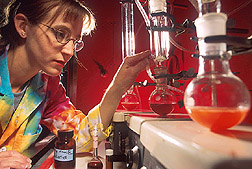This page has been archived and is being provided for reference purposes only. The page is no longer being updated, and therefore, links on the page may be invalid.
How Are You Fixed for Flavonoids?
By Rosalie Marion Bliss
January 10, 2007
What do red grapes, white onions, green and black teas and blackeye cowpeas all have in common? In addition to vitamins and minerals, these plant foods are rich in a class of chemical compounds called flavonoids.
The first update of the USDA Database for the Flavonoid Content of Selected Foods, Release 2, is now available. The new release provides analytical values for 26 selected flavonoid compounds in 393 foods.
For the update, scientists with the Agricultural Research Service (ARS) analyzed the flavonoids in nearly 60 representative fruits, nuts and vegetables taken from a nationwide sampling. In addition, data from nearly 100 new scientific papers on the flavonoid content of various foods were evaluated for inclusion.
The update project was led by nutritionists David Haytowitz and Seema Bhagwat at ARS' Nutrient Data Laboratory (NDL). They collaborated with colleagues at the ARS Food Composition Laboratory, led by chemist James Harnly. Both laboratories are among seven units at ARS' Beltsville (Md.) Human Nutrition Research Center. ARS is the chief scientific research agency of the U.S. Department of Agriculture.
The new release includes the quantities of the 26 selected flavonoids found in 168 new foods that have been added to the original database. Data for many of the food items included in the first release were also updated.
Research studies have consistently provided evidence suggesting an association between consumption of diets high in flavonoids and reduced risk of cancer and heart disease. Documenting the flavonoid content of foods is essential to researchers who strive to evaluate associations between dietary flavonoid intake and risk factors for various chronic diseases.
This supplemental flavonoid database complements the NDL's core product, The National Nutrient Database for Standard Reference, SR19, which is the major authoritative source of food composition information in the United States. Supplemental databases for other phytochemicals found at the NDL website include those for proanthocyanidins and isoflavones.
The new database is accessible from NDL's website.
It is available to read online and can be downloaded for use on personal computers as a PDF file.

